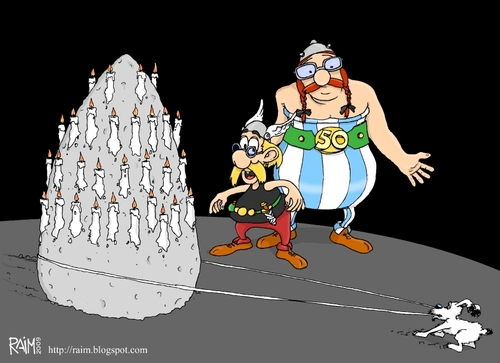
Asterix comics contain 700 traumatic brain injuries, say academics
Academics have carried out a detailed analysis of the 700 head injuries suffered by characters in the Asterix comic books, in a paper published by a respected medical journal.
The German scientists calculated that the “plucky little Gaul” and his sidekick Obelix were responsible for causing more than half of the wounds, “under the influence of a doping agent called ‘the magic potion’”, with Roman soldiers their most common victims.
They found that many of those who were knocked out in the 34 books, more commonly enjoyed by schoolboys than neurosurgeons, were often left with an outstretched tongue or amnesia but none appeared to die.
The researchers, led by Marcel Kamp at Heinrich Heine University in Düsseldorf, conclude: “The favourable outcome is astonishing, since outcome of traumatic brain injury in the ancient world is believed to have been worse than today and also since no diagnostic or therapeutic procedures were performed.”
Their paper, published in the official journal of the European Association of Neurosurgical Socities, known as Acta Neurochirurgica, sets out with no apparent irony their aim to “analyse the epidemiology and specific risk factors of traumatic brain injury in the Asterix illustrated comic books”.
They explain how in the books, published first in France in the 1960s and 1970s, the inhabitants of a small village in Gaul resist the Roman invasion with the help of a magic potion brewed by a druid.
The main characters “thump” Romans, pirates and Goths but a “detailed analysis had not been performed hitherto” of the injuries they suffered.
By “screening” all 34 books, the authors found 704 cases of head or brain injury, all but six suffered by men.
The victims were mostly Romans (450) but also included 120 Gauls, 59 bandits or pirates, 20 Goths, eight Vikings and five Britons. In 402 cases the perpetrators of the violence were Asterix and/or Obelix themselves.
In 696 cases “blunt force” was used but eight people were strangled and six suffered a fall.
More victims (390) suffered severe trauma than moderate (89) or mild (225), with the researchers using the standard Glasgow coma scale to assess the seriousness of their wounds.
About half (390) lost consciousness after being attacked and 188 were drawn with hypoglossal paresis – “an outstretched or sideward pointing tongue”. Half also had periorbital ecchymoses or “raccoon eyes” and some had “sporadic amnesia”.
The druid Getafix took the longest time to recover after “a case of massive force” in the form of a large stone known as a menhir falling on his head.
However the paper notes: “No case of death or a permanent neurological deficit following traumatic brain injury has been found.”
Most of those attacked were wearing helmets at the time but the “vast majority” lost this protective barrier “during the traumatic event”.
Asterix typically drank some of Getafix’s magic potion before fights.
“Ingestion of the magic potion by the aggressor was believed to give superhuman strength and was in fact associated with severe initial impairment of consciousness of the victims.”
However the researchers say that the potion was also used to treat wounds and point out that mistletoe, one of its key ingredients, “has been shown to have effects on brain tumours”.
In a comment piece, Karl Schaller, a neurosurgeon at the University of Geneva, describes the Asterix comics as “very important” in European history and adds: “Fighting against pretension of hegemony by the bad guys – be it on land or on water – has never been illustrated in a more decent, ironical and sometimes hilarious manner.
“Most interestingly, according to the analysis provided by this paper, it was not that dangerous either, given the low rate of serious injuries.”
……..and these moronic “academics actually get paid for this!!!!!!!!!!!!!












No comments:
Post a Comment